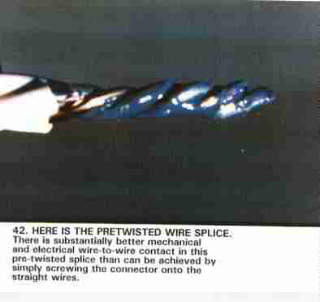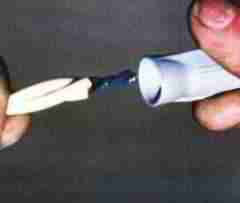 Scotchlok 3M Connector [now obsolete] Aluminum Wire alternative repair Method using a Specific Twist-on Connector - Details
Scotchlok 3M Connector [now obsolete] Aluminum Wire alternative repair Method using a Specific Twist-on Connector - Details
- POST a QUESTION or COMMENT about use of the Scotchlok-3M twist on connector for aluminum wiring repairs
This article describes a working alternative repair method for aluminum wiring [- Superceded by new alternate repair as of June 2007] but documented here as an aid to recognizing the occurrence of this repair method in existing installations.
InspectAPedia tolerates no conflicts of interest. We have no relationship with advertisers, products, or services discussed at this website.
- Daniel Friedman, Publisher/Editor/Author - See WHO ARE WE?
Alternative Aluminum Wire Repair Method Using the Scotchlok 3-M Connector & Special Details [obsolete]
The availability of the AlumiConn beginning in July 2007, a UL listed connector intended for this repair and which was tested successfully, resulted in our statement that the alternative method described here has been supersceded by a new alternative repair.
We have maintained this [now obsolete] repair description to aid in recognition of this repair in buildings where it may have been applied. Original quote:
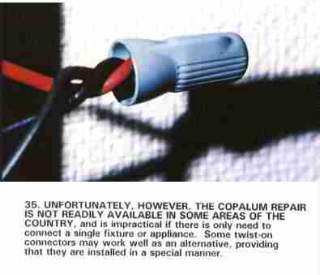 In this aluminum wiring repair method, in which copper pigtails were spliced to the aluminum wire ends using a specific twist-on connector, antioxidant, abrading, and pre-twisting of the wires. Independent testing of this method indicated that provided the work was performed correctly these splices performed well and could significantly reduce the risk of aluminum-wire caused fires in buildings.
In this aluminum wiring repair method, in which copper pigtails were spliced to the aluminum wire ends using a specific twist-on connector, antioxidant, abrading, and pre-twisting of the wires. Independent testing of this method indicated that provided the work was performed correctly these splices performed well and could significantly reduce the risk of aluminum-wire caused fires in buildings.
This repair was considered appropriate for cases where the AMP TYCO COPLAUM connector method and electricians trained to use that method were not available.
How to Apply a Special Aluminum Wire Repair Method For Use When the COPALUM Method is Not Available [Obsolete as of June 2011]
For in-depth discussion of the procedures described below also see Reducing the Fire Hazard in Aluminum-Wired Homes by Dr. Jesse Aronstein.
Click any image to see an enlarged version.
This is Aluminum Wiring Repair Procedure - Page 12 Color photos and descriptive captions from a CPSC Meeting held on 9/28/95. This presentation describes an alternative repair method for aluminum wiring which was at that time considered useful where the AMP TYCO COPALUM special connector and electricians trained to use it were not available.
This alternative repair for aluminum electrical wiring used readily-available components. It was tested and found reliable when performed by a properly trained licensed electrician or similarly qualified expert. As with any electrical wiring repair, but perhaps even more important in this case where the starting point is unsafe aluminum electrical wiring, it was essential that the repair procedure was correctly performed.
This document presents color photos and descriptive captions from the CPSC Meeting on 9/28/95 where this aluminum wiring repair method was described. In this document aluminum wire twist-on connector failures and repair procedures are described, including aluminum wire repair methods which work and methods which do not work and are unsafe. Color photos of aluminum wire repair procedures, and photos of failed connectors are included.
This document series describes hazards with existing aluminum wiring repair products, explains the aluminum wiring failure mechanism, and reviews recommended retrofit procedures including use of readily-available materials. This information was presented to the US Consumer Product Safety Commission by Dr. J. Aronstein, 9/28/95.
The US CPSC minutes were obtained under the Freedom of Information Act and posted by Daniel Friedman January 1996, updated June 2007 to reflect the availability of a new alternative to the COPALUM, the AlumiConn, and noting that the use of the Scotchlok 3-M method described here is - superceded by new alternate repair as of June 2007.
35. Unfortunately, however, the COPALUM repair is not readily available in some areas of the country, and is impractical if there is only need to connect a single fixture or appliance. Some twist-on
connectors may work well as an alternative, providing that they are installed in a special manner - superceded by new alternate repair as of June 2007.

36. The special installation method described here - superceded by new alternate repair as of June 2007 - is based on industry (Ideal, GE, Etc) recommended practice considered to be necessary for proper connection to aluminum. The wires are stripped
over length, and a coating of oxide inhibitor is applied.
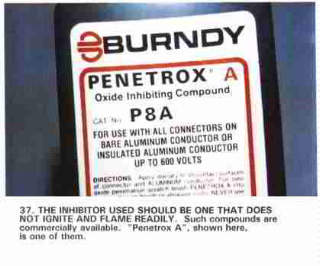
37. The inhibitor used should be one that does not ignite and flame readily. Such compounds are commercially available. "Penetrox A," shown here, is one of them.
Orrey W. Hiebert was kind enough to suggest another inhibitor: Burndy Pentrox A which he says does not ignite. These compounds are available from most electrical wholesale suppliers.
A contemporary
version of De-Ox by Ilsco, a gel that comes in a white squeeze bottle, is reported by some of our readers to no longer support combustion.
[Email from G.S to DJF 11/16/06)].
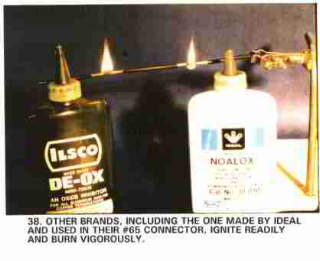
38. Other brands, including the one, NOALOX(TM) made by Ideal and used in their #65 connector, ignite readily and burn vigorously.
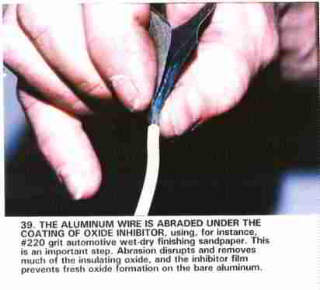
39. The aluminum wire is abraded under the coating of oxide inhibitor, using, for instance, #220 grit automotive wet-dry finishing sandpaper. This is an important step. Abrasion disrupts and removes much of the insulating oxide, and the inhibitor film prevents fresh oxide formation on the bare aluminum. Scroll Down to Rest of This Page
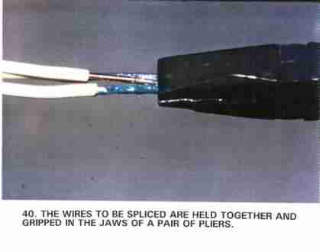
40. The wires to be spliced are held together and gripped in the jaws of a pair of pliers.
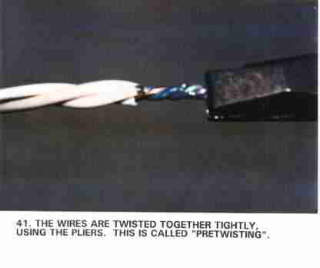
41. The wires are twisted together tightly, using the pliers. This is called "pre twisting."
42. Here is the pre twisted wire splice.
There is substantially better mechanical and electrical wire-to-wire contact in this pre-twisted splice than can be achieved by simply screwing the connector
onto the straight wires.

43. The excess length of the twisted wire splice is then cut back to the length specified for the connector that is to be used.
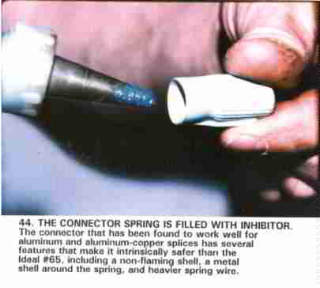
44. The connector spring is filled with inhibitor.
The connector that has been found to work well for aluminum and aluminum-copper splices (3M Scotchlok, available from most electrical wholesalers) has several features that make it intrinsically safer than the Ideal #65, including a non-flaming shell, a metal shell around the spring, and heavier spring wire.
The 3M "Scotchlok" connectors are generally available in four sizes, designated
on the box (of 100) as product model "Y", "R", "G", or "B" (in increasing order
of size). The model designation corresponds to the color of the insulating shell
(yellow, red, green, or blue). The "R" and "G" are the most useful sizes for
aluminum wire pigtailing of the #12 and #10 wire (15 and 20 amp circuits,
respectively).
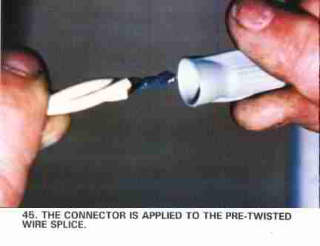
45. The connector is applied to the pre-twisted wire splice.
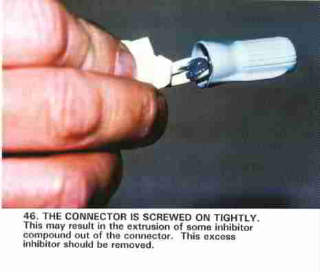
46. The connector is screwed on tightly. This may result in the extrusion of some exhibitor compound out of the connector. This excess should be removed. Scroll Down to Rest of This Page
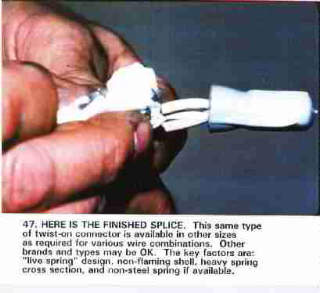
47. Here [above] is the finished splice. This same type of twist-on connector is available in other sizes as required for various wire combinations.
Other brands and types may be OK. The key factors are:
"live spring" design, non-flaming shell, heavy spring cross section, and non-steel spring if available.
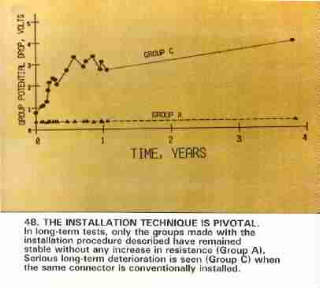
48. The installation technique is pivotal. In long-term tests, only the groups made with the installation procedure described have been stable without any increase in resistance (Group A). Serious
long-term degradation is seen (Group C) when the same connector is conventionally installed.
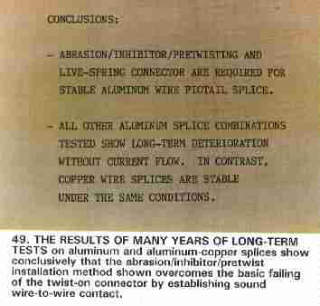
49. The results of many years of long-term tests on aluminum and aluminum-copper splices show conclusively that the abrasion/inhibitor/pre twist installation method shown overcomes the basic failing of the twist-on connector by establishing sound wire-to-wire contact.
...
Continue reading at ALUMINUM WIRING REPAIR SPECIAL CONCERNS or select a topic from the closely-related articles below, or see the complete ARTICLE INDEX.
Or see these
Aluminum Wiring Repair Articles
- ALUMINUM WIRING HAZARDS & REPAIRS - home
- ALUMINUM WIRING IDENTIFICATION
- ALUMINUM WIRING REPAIR METHODS
- ALUMINUM WIRING REPAIR ELECTRICIANS
- ALUMINUM WIRING REPAIR METHODS - CPSC Meeting 9/28/95
- COPPER PIGTAILING for ALUMINUM WIRE
- COPPER PIGTAILING FAILURES in ALUMINUM WIRING
- ALUMINUM WIRING FIELD FAILURES
- ALUMINUM WIRE to WIRE CONTACT
- ALUMINUM WIRING EQUIVALENT CIRCUITS
- ALUMINUM WIRING CONNECTOR CURRENT FLOW
- ALUMINUM WIRING CONNECTOR DETERIORATION
- ALUMINUM WIRING CONNECTOR UL TEST INADEQUATE
- ALUMINUM WIRING SPECIAL CONNECTOR FAILURES
- AMP TYCO COPALUM CONECTORS
- SCOTCHLOK 3M REPAIR CONNECTORS
- ALUMINUM WIRING REPAIR SPECIAL CONCERNS
- ALUMINUM WIRING REPAIRS NOT-RECOMMENDED
- REDUCE THE AL WIRE RISK: DETAILS
Suggested citation for this web page
SCOTCHLOK 3M REPAIR CONNECTORS at InspectApedia.com - online encyclopedia of building & environmental inspection, testing, diagnosis, repair, & problem prevention advice.
Or see this
INDEX to RELATED ARTICLES: ARTICLE INDEX to ELECTRICAL INSPECTION & TESTING
Or use the SEARCH BOX found below to Ask a Question or Search InspectApedia
Ask a Question or Search InspectApedia
Questions & answers or comments about use of the Scotchlok-3M twist on connector for aluminum wiring repairs.
Try the search box just below, or if you prefer, post a question or comment in the Comments box below and we will respond promptly.
Search the InspectApedia website
Note: appearance of your Comment below may be delayed: if your comment contains an image, photograph, web link, or text that looks to the software as if it might be a web link, your posting will appear after it has been approved by a moderator. Apologies for the delay.
Only one image can be added per comment but you can post as many comments, and therefore images, as you like.
You will not receive a notification when a response to your question has been posted.
Please bookmark this page to make it easy for you to check back for our response.
Our Comment Box is provided by Countable Web Productions countable.ca
Citations & References
In addition to any citations in the article above, a full list is available on request.
- [1]AlumiConn [Website: AlCopStore.com ] ™ AlCopStore.com 223 Salt Lick Road, #279, St. Peters, MO 63376
Tel: 866-826-2256, Fax: 636-754-0500, Email Sales: pking@AlCopStore.com, Email General Inquiry: info@AlCopStore.com - [2] "Repairing Aluminum Wiring," [As updated 2011] U.S. Consumer Product Safety Commission Publication available online
- [3] "Record of Commission Action, Commissioners Voting by Ballot", CPSC Publication No. 516, Repairing Aluminum Wiring (original version op.cit.), (Briefing package dated March 15, 2011), Quoting:
The Commission voted unanimously (5-0)·to approve republication of CPSC Publication No. 516, Repairing Aluminum Wiring, with the explicit recognition that the COPALUM and AlumiConn connectors currently are the only products that meet the agency's standards to prevent aluminum wire fire hazards
Copy on file as /aluminum/Pub516_Alumi_Conn.pdf - [4] Dr. Jess Aronstein, protune@aol.com is a research consultant and an electrical engineer in Schenectady, NY. Dr. Aronstein provides forensic engineering services and independent laboratory testing for various agencies. Dr. Aronstein has published widely on and has designed and conducted tests on aluminum wiring failures, Federal Pacific Stab-Lok electrical equipment, and numerous electrical products and hazards. See ALUMINUM WIRING BIBLIOGRAPHY and see FPE HAZARD ARTICLES, STUDIES for examples.
- [5] "The Influence of Corrosion Inhibitor and Surface Abrasion on the Failure of Aluminum-Wired Twist-on Connections", Aronstein, J.; Campbell, W., Components, Hybrids, and Manufacturing Technology, IEEE Transactions on Volume 7, Issue 1, Mar 1984 Page(s): 20 - 24
- [6] Thanks to reader Thomas Kremer for suggesting clarification to this topic 08/09
- [7] Personal communication, Email, P. King to D Friedman, 3/10/2012 [copy on file AlumiConn_PK120310.pdf].
- Fire Hazards With Aluminum to Copper Twist-on Connectors & Acceptable Aluminum Wiring Repair Practices Color Photos, Current Issues. 9/28/95 CPSC Meeting Minutes
- REPAIRING ALUMINUM WIRING, US CPSC Pub. No. 516 U.S. Consumer Product Safety Commission Publication available online
- In addition to citations & references found in this article, see the research citations given at the end of the related articles found at our suggested
CONTINUE READING or RECOMMENDED ARTICLES.
- Carson, Dunlop & Associates Ltd., 120 Carlton Street Suite 407, Toronto ON M5A 4K2. Tel: (416) 964-9415 1-800-268-7070 Email: info@carsondunlop.com. Alan Carson is a past president of ASHI, the American Society of Home Inspectors.
Thanks to Alan Carson and Bob Dunlop, for permission for InspectAPedia to use text excerpts from The HOME REFERENCE BOOK - the Encyclopedia of Homes and to use illustrations from The ILLUSTRATED HOME .
Carson Dunlop Associates provides extensive home inspection education and report writing material. In gratitude we provide links to tsome Carson Dunlop Associates products and services.



